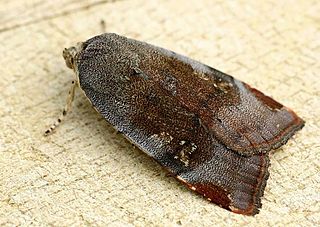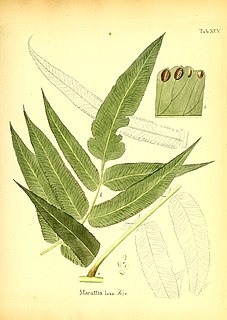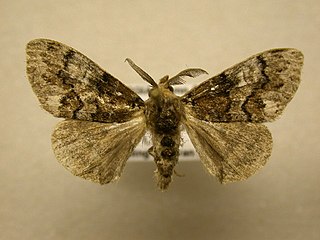Related Research Articles

Noctua is a genus of moths. They have dull, cryptic forewings and often very bright hindwings. These are hidden under the forewings when the moths rest, leading to their common name of yellow underwings. They are not particularly closely related to the "true" underwing moths (Catocala) though, apart from both being Noctuoidea. They are good fliers.
Coreura is a genus of moths in the subfamily Arctiinae. The genus was erected by Francis Walker in 1865.

Noctua interposita is a moth of the family Noctuinae. It is found in Europe.

Marattia is a small genus of primitive, large, fleshy eusporangiate ferns. It is the type genus of the family Marattiaceae, order Marattiales and class Marattiopsida. Formerly considered to be a much larger genus, genetic analysis has shown that Marattia in the broad sense was paraphyletic, and subsequently the genera Ptisana and Eupodium were split off. Except for one species in Hawaii, the genus is neotropical.
Alaena interposita is a butterfly in the family Lycaenidae. It is found in Tanzania. The habitat consists of Brachystegia woodland.
Coreura albicosta is a moth of the subfamily Arctiinae. It was described by Max Wilhelm Karl Draudt in 1915. It is found in Mexico.
Coreura alcedo is a moth of the subfamily Arctiinae. It was described by Max Wilhelm Karl Draudt in 1915.
Coreura cerealia is a moth of the subfamily Arctiinae. It was described by Druce in 1897. It is found in Ecuador.
Coreura eion is a moth of the subfamily Arctiinae. It was described by Herbert Druce in 1896. It is found in Costa Rica and Panama.
Coreura engelkei is a moth of the subfamily Arctiinae. It was described by Rothschild in 1912. It is found in Colombia.
Coreura euchromioides is a moth of the subfamily Arctiinae. It was described by Francis Walker in 1864. It is found in Colombia.
Coreura fida is a moth of the subfamily Arctiinae. It was described by Jacob Hübner in 1827. It is found in Mexico and Brazil.
Coreura lysimachides is a moth of the subfamily Arctiinae. It was described by Herbert Druce in 1897. It is found in Ecuador and Peru.
Coreura simsoni is a moth of the subfamily Arctiinae. It was described by Druce in 1885. It is found in Colombia, Ecuador and Bolivia.
Coreura sinerubra is a moth of the subfamily Arctiinae. It was described by William James Kaye in 1919. It is found in Peru.
Coreura phoenicides is a moth of the subfamily Arctiinae. It was described by Herbert Druce in 1884. It is found in Guatemala and Costa Rica.
The Euchromiina are a subtribe of tiger moths in the family Erebidae. It was described by Arthur Gardiner Butler in 1876. Many species in the subtribe are mimics of wasps.

Polygonia interposita is a butterfly of the family Nymphalidae. It is found from Ghissar to the Altai Mountains, north-western China, the Himalayas and Mongolia. The habitat consists of gorges and slopes up to 2,500 meters above sea level.
Ethmia interposita is a moth in the family Depressariidae. It was described by Sattler in 1967. It is found in Palestine.

Dasychira manto, the Manto tussock moth, is a species of tussock moth in the family Erebidae. It was first described by Herman Strecker in 1900 and it is found in North America.
References
- ↑ Beccaloni, G.; Scoble, M.; Kitching, I.; Simonsen, T.; Robinson, G.; Pitkin, B.; Hine, A.; Lyal, C., eds. (2003). "Coreura interposita". The Global Lepidoptera Names Index . Natural History Museum . Retrieved April 30, 2018.
| This Euchromiina-related article is a stub. You can help Wikipedia by expanding it. |